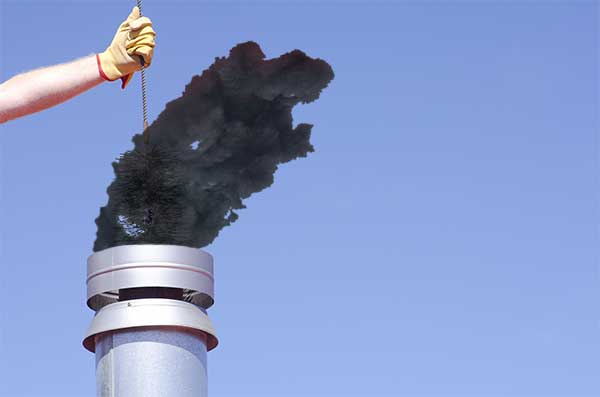

We all know that if you have a fireplace or a wood-burning stove, you need to have the chimney serviced each season. The big question is why? You put wood on the fire, the fire creates smoke, and the chimney vents the smoke out of your home, so what is there to inspect? One of the biggest dangers of the fireplace and wood-burning stove use is creosote buildup in the chimney. Prior to putting that first log on the fire, call in an expert Ocean County chimney service expert. Annual chimney inspections help keep your home and family safe from accidental fire.
What is Creosote?
Creosote is a very dangerous byproduct of burning wood. The oils in the wood are typically not completely combusted by a normal fire and they are released into the chimney along with the smoke where they can form deposits in the flue. Creosote buildup is categorized in 3 stages which we will go over now. Stage 1 is when the creosote found in your chimney is flaky and easily brushed off. The next stage, stage 2, is when the deposit turns into a tar-like substance. This substance is difficult to remove and usually needs to be taken care of by a professional. Stage 3 is reached when the creosote becomes hardened in the chimney and is extremely challenging to get rid of. At this stage, it can also melt and drip like candle wax.
Why is it dangerous?
Not only does an extreme buildup of creosote increase the likelihood of an unintentional fire, but it can also be detrimental to your health. Creosote is toxic. It can cause a variety of respiratory issues as well as irritation to your skin and eyes. It is also known to be a carcinogen so long term exposure comes to an increased risk of cancer. Creosote is highly flammable and can, therefore, cause major damage to your chimney and home if not taken care of appropriately. When a fire forms in the chimney outside of your fireplace or wood-burning stove, it can easily destroy and ravage all the safety items contained in the chimney. The flue is not meant to withstand the level of heat a fire inside it can reach. Once the liner and flue breakdown, the risk of a home fire is imminent.
How do you handle it?
Call in a professional! While a visual inspection by the homeowner is never a bad thing, most people lack the tools and ability to thoroughly check all the parts of the chimney to ensure a safe wood burning season. A professional chimney service will check for wear and tear on all parts of the chimney and advise you if anything needs to be replaced. When it comes to creosote, leave it to the pros. As mentioned above, it can be very hazardous to your health when not handled in an appropriate manner. To help avoid creosote buildup, burn smart.
- Use only dry, seasoned wood
- Avoid slow, smoldering fires
- Burn hot fires with plenty of air
- Don’t burn packaged or artificial logs
When fall rolls around, and the nights start getting chilly before you reach for the first log to put on the fire, reach for your phone and call in an Ocean County chimney service from Carlin Chimney and Duct Service!
Fire Sefety Tips and Why They Matter
Creosote buildup is a common concern for homeowners with fireplaces or wood-burning stoves. It forms as a byproduct of burning wood and can accumulate along the inner walls of chimneys, posing a fire hazard. Here are some tips to help you limit creosote accumulation and ensure your fireplace or stove operates safely. By following these tips, you can limit creosote buildup and enjoy your fireplace or wood stove safely.

Burn Dry, Seasoned Wood
The moisture content of your firewood plays a crucial role in creosote formation. Burn only dry, seasoned wood, as it burns hotter and more efficiently, reducing the amount of smoke and soot produced. Freshly cut wood typically contains high levels of moisture and should be allowed to dry (season) for at least six months before use.
Maintain Proper Airflow
Airflow is critical to maintaining an efficient burn. Always open the damper fully when starting a fire to ensure proper oxygen supply and reduce the amount of smoke entering the chimney. For wood stoves, adjust the air intake to promote complete combustion. Incomplete combustion leads to cooler temperatures in the flue, which increases the likelihood of creosote condensation.
Use a Hot, Controlled Fire
Burning a hot, steady fire minimizes creosote formation. Avoid burning “slow” fires, as they produce more smoke and cooler temperatures in the flue, which encourage creosote to stick. When starting a fire, use small pieces of wood or kindling to quickly establish a hot base, then add larger logs gradually to maintain a consistent, hot burn.
Avoid Burning Non-Wood Materials
Burning paper, cardboard, or other non-wood materials can increase creosote buildup. These materials often burn unevenly, causing rapid temperature fluctuations that allow more creosote to form. Stick to burning only seasoned hardwoods, such as oak, maple, or hickory, which produce more heat and less creosote.

